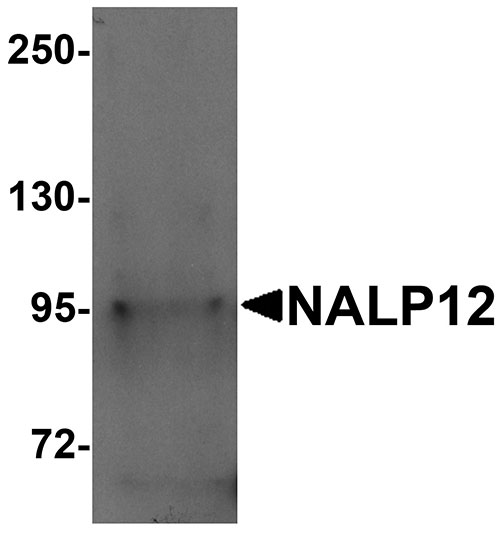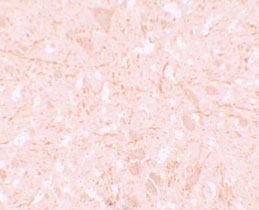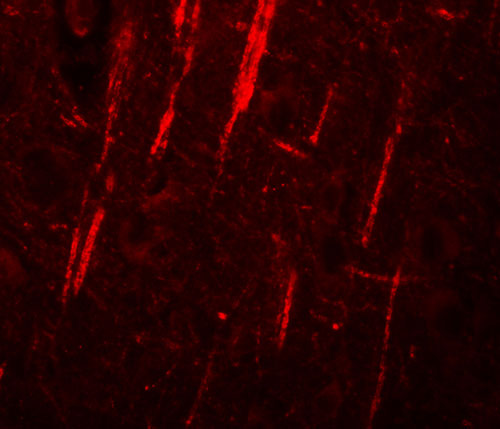NALP12 Antibody
- SPECIFICATION
- CITATIONS
- PROTOCOLS
- BACKGROUND

Application
| WB, IHC-P, IF, E |
|---|---|
| Primary Accession | P59046 |
| Other Accession | NP_653288, 21955154 |
| Reactivity | Human, Mouse, Rat |
| Host | Rabbit |
| Clonality | Polyclonal |
| Isotype | IgG |
| Calculated MW | 120173 Da |
| Application Notes | NALP12 antibody can be used for detection of NALP12 by Western blot at 1 µg/mL. Antibody can also be used for immunohistochemistry starting at 5 µg/mL. For immunofluorescence start at 20 µg/mL. |
| Gene ID | 91662 |
|---|---|
| Target/Specificity | NLRP12; |
| Reconstitution & Storage | NALP12 antibody can be stored at 4℃ for three months and -20℃, stable for up to one year. As with all antibodies care should be taken to avoid repeated freeze thaw cycles. Antibodies should not be exposed to prolonged high temperatures. |
| Precautions | NALP12 Antibody is for research use only and not for use in diagnostic or therapeutic procedures. |
| Name | NLRP12 |
|---|---|
| Synonyms | NALP12, PYPAF7, RNO |
| Function | Plays an essential role as an potent mitigator of inflammation (PubMed:30559449). Primarily expressed in dendritic cells and macrophages, inhibits both canonical and non-canonical NF-kappa-B and ERK activation pathways (PubMed:15489334, PubMed:17947705). Functions as a negative regulator of NOD2 by targeting it to degradation via the proteasome pathway (PubMed:30559449). In turn, promotes bacterial tolerance (PubMed:30559449). Also inhibits the RIGI- mediated immune signaling against RNA viruses by reducing the E3 ubiquitin ligase TRIM25-mediated 'Lys-63'-linked RIGI activation but enhancing the E3 ubiquitin ligase RNF125-mediated 'Lys-48'-linked RIGI degradation (PubMed:30902577). Also acts as a negative regulator of inflammatory response to mitigate obesity and obesity-associated diseases in adipose tissue (By similarity). |
| Cellular Location | Cytoplasm. |
| Tissue Location | Detected only in peripheral blood leukocytes, predominantly in eosinophils and granulocytes, and at lower levels in monocytes. |

Thousands of laboratories across the world have published research that depended on the performance of antibodies from Abcepta to advance their research. Check out links to articles that cite our products in major peer-reviewed journals, organized by research category.
info@abcepta.com, and receive a free "I Love Antibodies" mug.
Provided below are standard protocols that you may find useful for product applications.
Background
NALP12 Antibody: NALP proteins are cytoplasmic proteins that form a subfamily within the larger CATERPILLER family and are thought to play a crucial role in cell proliferation and reproduction. Like all other NALP family members, NALP12, also known as Monarch-1, has a C-terminal leucine-rich repeat (LRR) region, an N-terminal Pyrin domain (PYD) followed by a NACHT domain, and a NACHT-associated domain. NALP12 is thought to act as an attenuating factor of inflammation by suppressing inflammatory responses such as NF-κB activation by TLR-signaling molecules MyD88, IRAK-1, TRAF6 and RIPK1 in activated monocytes. Recent evidence suggests that mutations in NALP12 result in hereditary periodic fever syndromes.
References
Tschopp J, Martinon F, and Burns K. NALPs: a novel protein family involved in inflammation. Nat. Rev. Mol. Cell Biol.2003; 4:95-104.
Tian X, Pascal G, and Monget P. Evolution and functional divergence of NLRP genes in mammalian reproductive system. BMC Evol. Biol.2009; 9:202.
Williams KL, Lich JD, Duncan JA, et al. The CATERPILLER protein Monarch-1 is an antagonist of toll-like receptor- , tumor necrosis factor a-, and Mycobacterium tuberculosis-induced pro-inflammatory signals. J. Biol. Chem.2005; 48:39914-24.
Jeru I, Duquesnoy P, Fernandes-Alnemri T, et al. Mutations in NALP12 cause hereditary periodic fever syndromes. Proc. Natl. Acad. Sci. USA2008; 105:1614-9.
If you have used an Abcepta product and would like to share how it has performed, please click on the "Submit Review" button and provide the requested information. Our staff will examine and post your review and contact you if needed.
If you have any additional inquiries please email technical services at tech@abcepta.com.













 Foundational characteristics of cancer include proliferation, angiogenesis, migration, evasion of apoptosis, and cellular immortality. Find key markers for these cellular processes and antibodies to detect them.
Foundational characteristics of cancer include proliferation, angiogenesis, migration, evasion of apoptosis, and cellular immortality. Find key markers for these cellular processes and antibodies to detect them. The SUMOplot™ Analysis Program predicts and scores sumoylation sites in your protein. SUMOylation is a post-translational modification involved in various cellular processes, such as nuclear-cytosolic transport, transcriptional regulation, apoptosis, protein stability, response to stress, and progression through the cell cycle.
The SUMOplot™ Analysis Program predicts and scores sumoylation sites in your protein. SUMOylation is a post-translational modification involved in various cellular processes, such as nuclear-cytosolic transport, transcriptional regulation, apoptosis, protein stability, response to stress, and progression through the cell cycle. The Autophagy Receptor Motif Plotter predicts and scores autophagy receptor binding sites in your protein. Identifying proteins connected to this pathway is critical to understanding the role of autophagy in physiological as well as pathological processes such as development, differentiation, neurodegenerative diseases, stress, infection, and cancer.
The Autophagy Receptor Motif Plotter predicts and scores autophagy receptor binding sites in your protein. Identifying proteins connected to this pathway is critical to understanding the role of autophagy in physiological as well as pathological processes such as development, differentiation, neurodegenerative diseases, stress, infection, and cancer.




